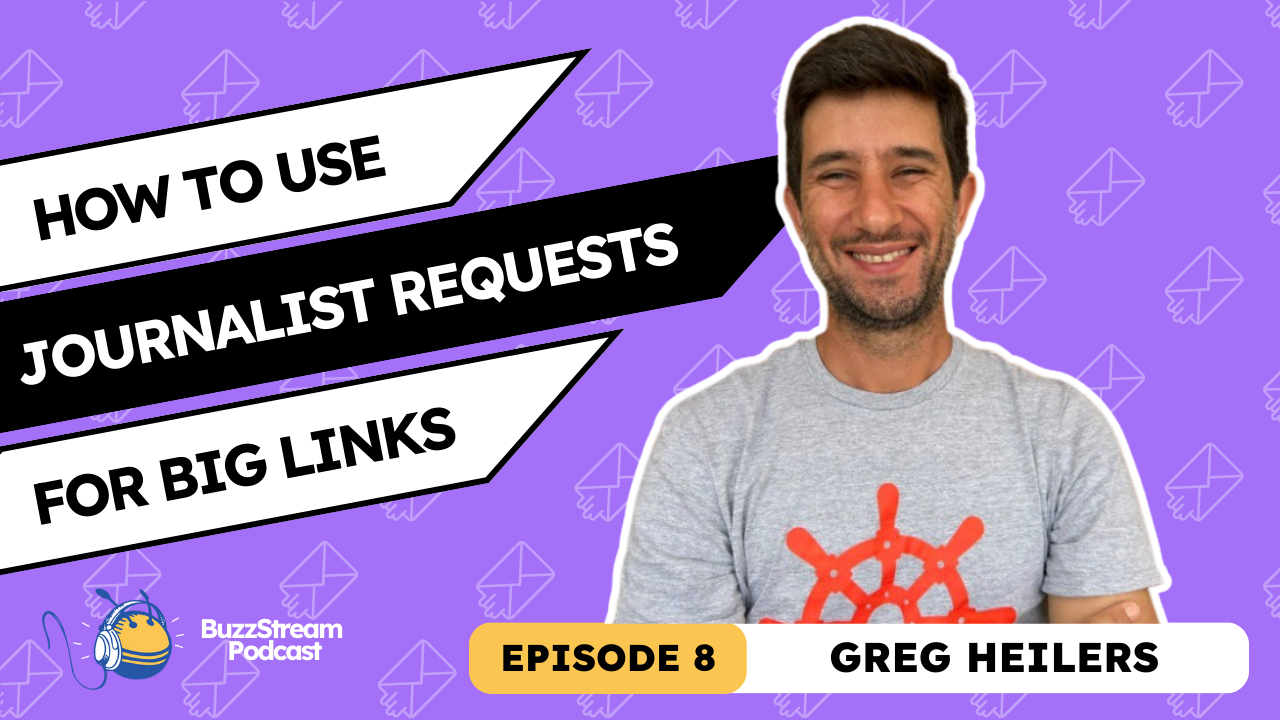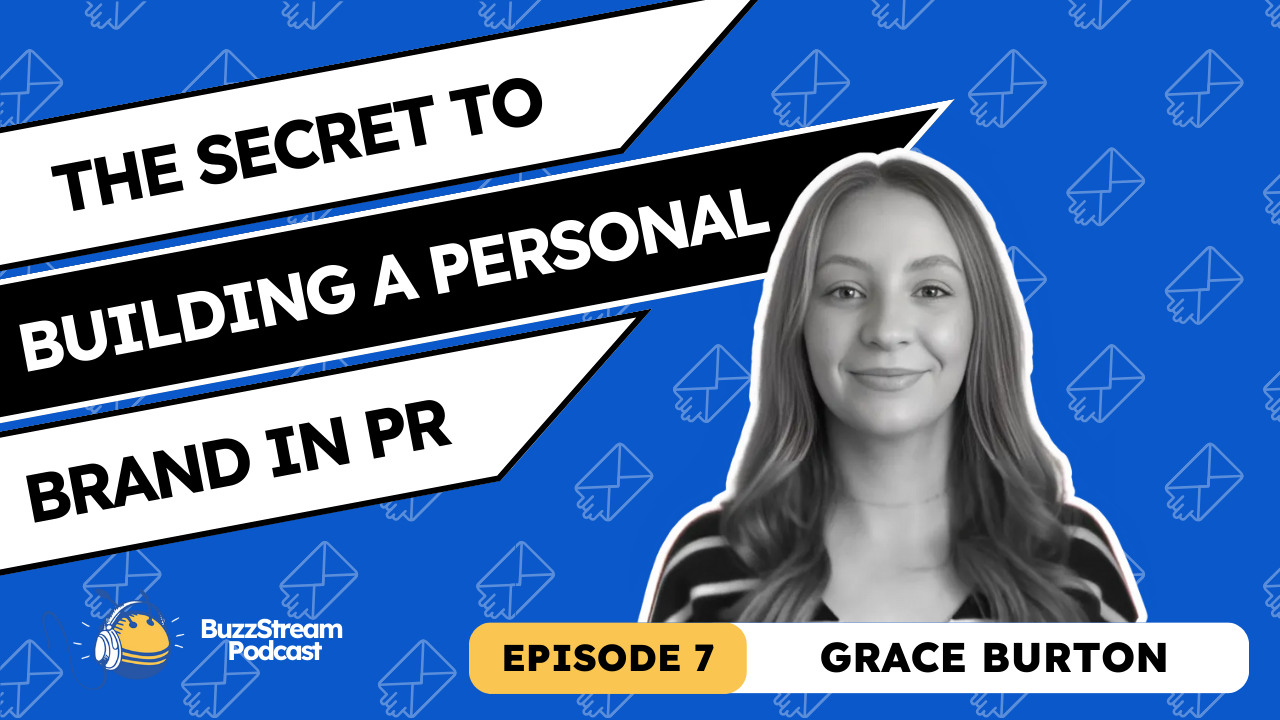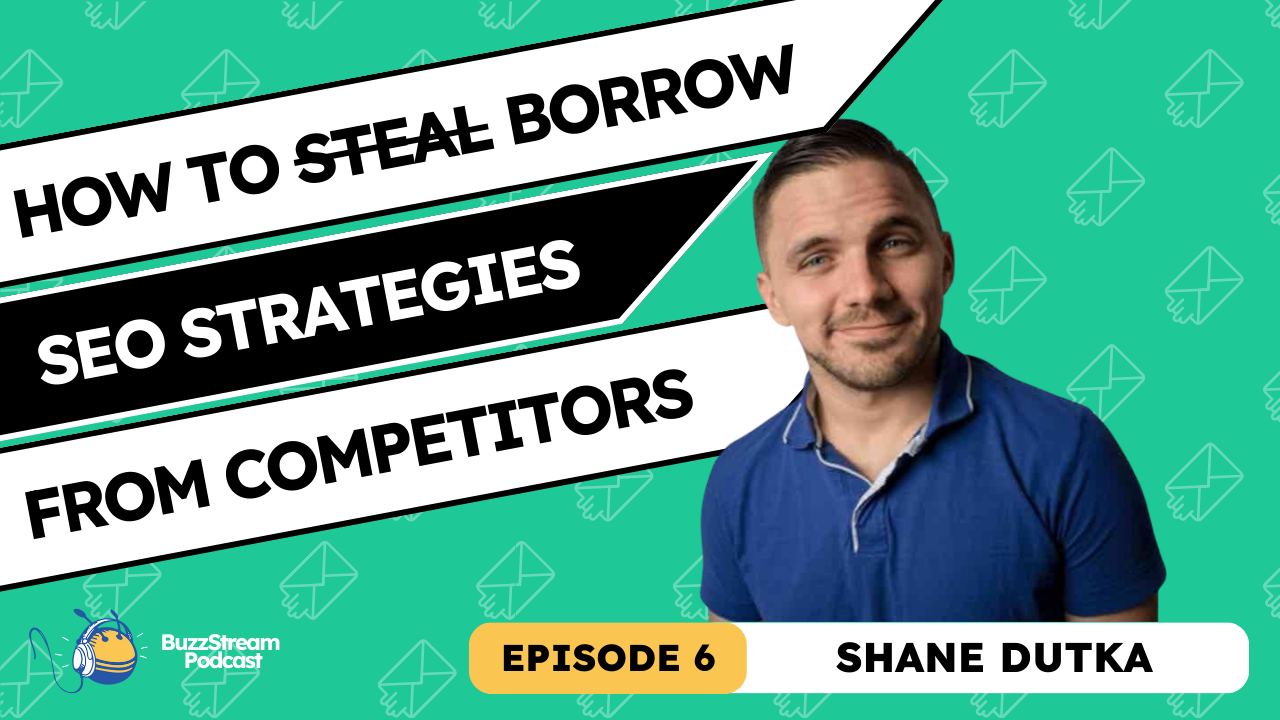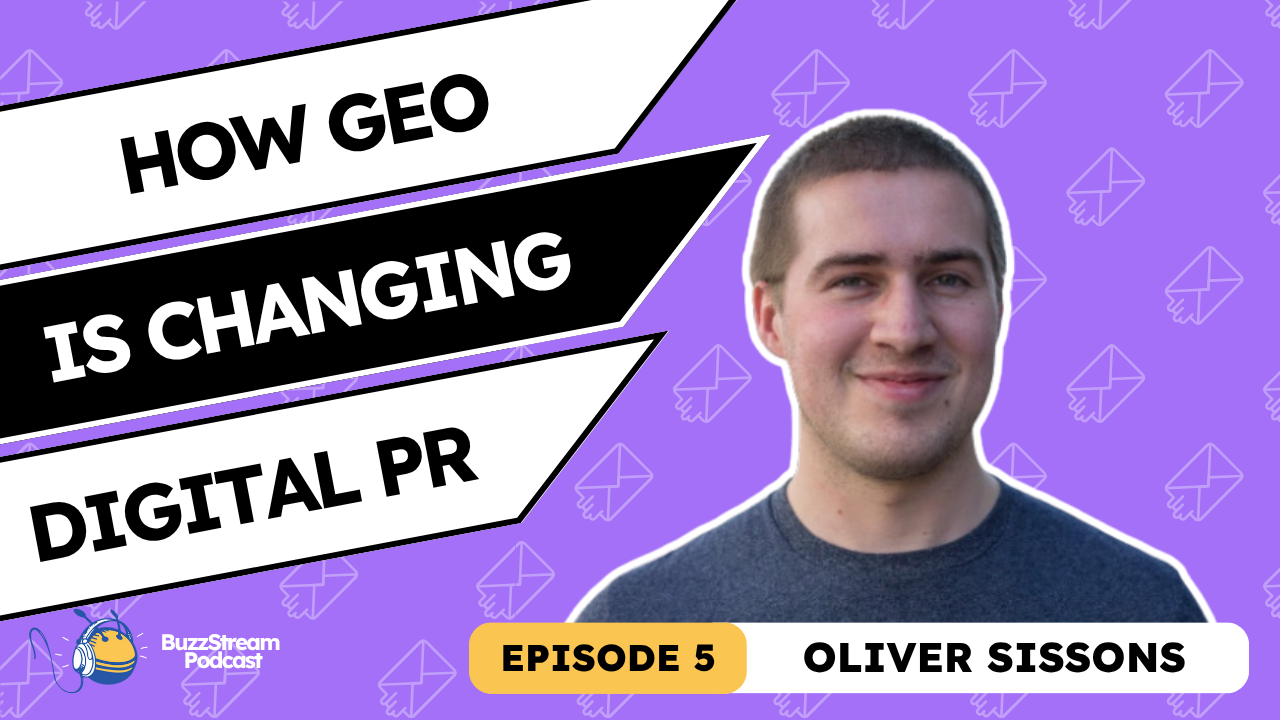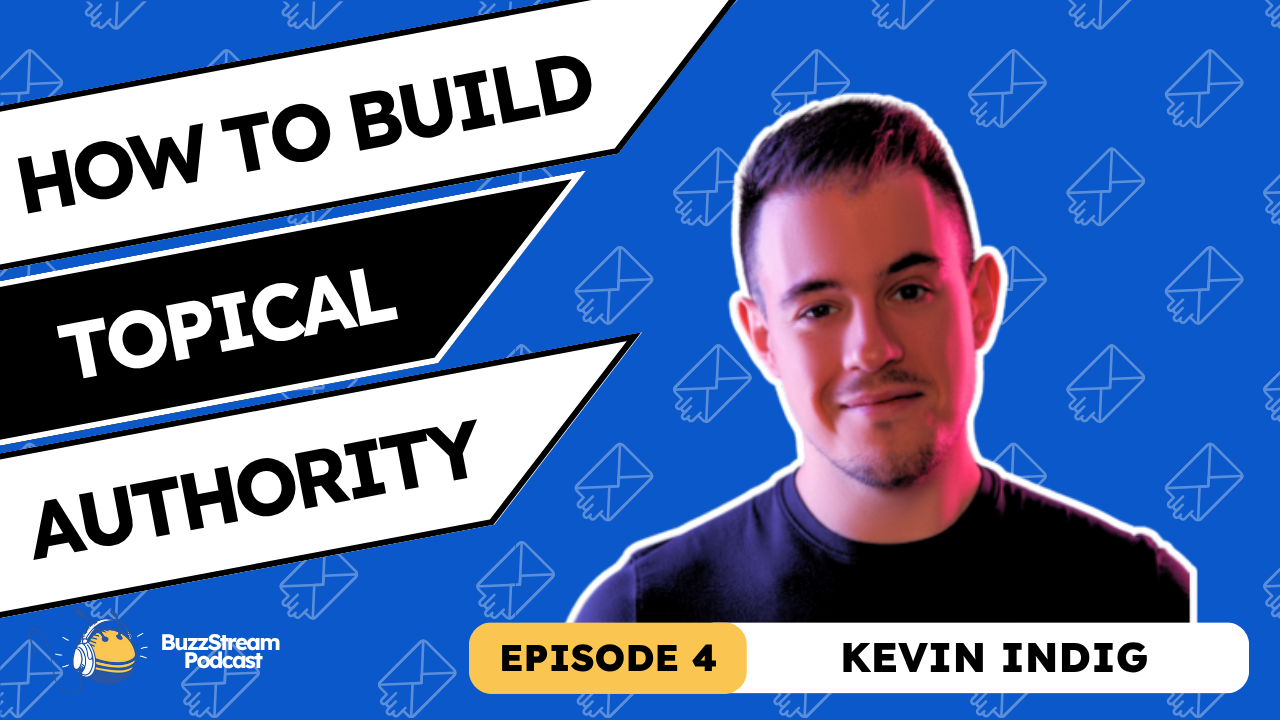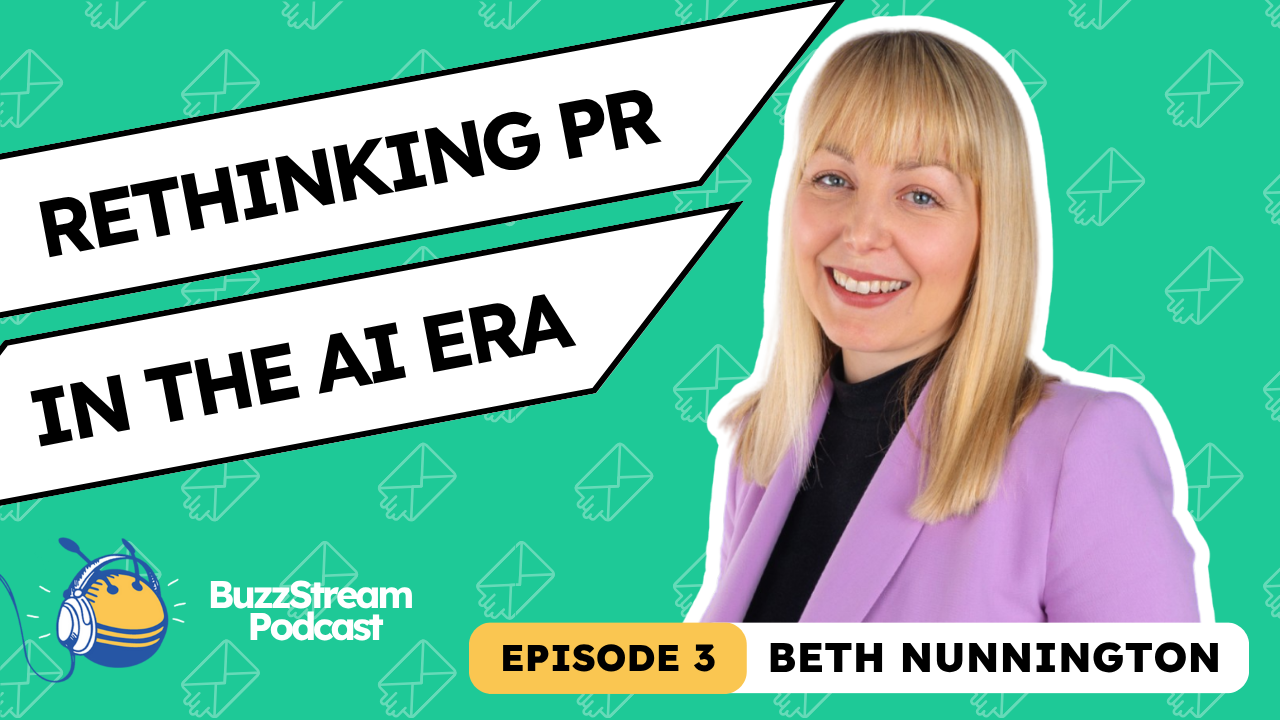Table of Contents
In this episode of the BuzzStream podcast, I chat with Doug Downs, the principal at Stories and Strategies Podcast Productions.
I first met Doug after checking out his podcast while researching the best PR podcasts on the web. Doug graciously invited me to appear on his podcast as a guest, which you can check out here.
As Doug is an expert in all things podcasting, I figured picking his brain about pitching yourself or your clients to get on podcasts would be an excellent opportunity.
Tune in to learn how to appear on podcasts and use them for brand awareness and link generation.

Actionable Takeaways
Here are some actionable takeaways from the conversation.
First, here are some for aspiring podcast guests:
1. Ditch the Templates
Generic mass-pitching doesn’t work. Research the podcast, reference past episodes, and pitch a compelling episode idea that aligns with their audience.
2. Use Transcripts for Better Personalization
You don’t necessarily have to listen to an entire episode to personalize (although it’s probably better that you do). You can pull transcripts from Apple Podcasts or YouTube and have ChatGPT pull out key insights to help you tailor your pitch.
3. Prioritize Relevance Over Volume
Mass pitching might land you spots on low-quality podcasts. Instead, focus on podcasts with engaged audiences relevant to your niche.
4. Gauge Podcast Quality with Tools
Before pitching, use platforms like Listen Notes and Rephonic to check a show’s ranking and listenership.
Then, here are some for those who are thinking of starting a podcast (or want to know how to make their’s better.)
5. Think of Your Podcast as a Gift, Not a Sales Pitch
I love this concept. Content is a gift! This keeps it from sounding too commercial. Instead, use it to educate, entertain, and build relationships with your audience.
6. Use Your Podcast for Multi-Channel Content
Repurpose episodes into blog posts, social media snippets, newsletters, and even books. Your content should work harder for you!
7. Find Your Podcast’s “25th Hour” Appeal
Your audience is most likely tuning into your podcast while multitasking. Give them something that makes their 25th hour of the day worthwhile. Keep your show engaging with storytelling, behind-the-scenes insights, and compelling narratives.
8. Don’t Ignore Video
More people are discovering podcasts via YouTube. Even if you don’t go full video, consider using short clips or audiograms to grow your audience.
Resources Mentioned
Here are some of the links and resources mentioned by Doug.
- Rephonic: A podcast intelligence tool that helps users discover, analyze, and connect with podcasts based on audience data and networking insights.
Transcript
Here’s a slightly modified transcript of our chat!
What makes a good podcast pitch?
Doug: I’ll start with what makes a bad one. Man, does that ever stand out?
The inevitable template, bad podcast pitches, dear podcast or podcaster. I was listening to the podcast, and your episode about the latest episode that they just blocked copied off of my site got me thinking. It’s genuinely some great content that I think you would be interested in. I know darn well that is a template that they’re sending out, and they’re inserting things into the template, and AI might even insert the name of the podcast. Now, for all I know, they’ve spent zero time trying to understand me, trying to understand my audience.
Trying to understand the guests that we’ve had on. They’re also not pitching an episode idea, which is what I, in particular, what I’m interested in. So my recommendation is don’t do that. Don’t be templatey with, with, and I know there’s a tendency to want to go at it by volume, right? Surely, if I pump a thousand of these things out, I’ll land 10.
You probably will. Problem with that is it’s probably the 10 that are desperately looking for guests, maybe trying to fill a hole or they’re not very well listened to. So, so that’s the weakness in that approach. I think what makes a really good pitch is when you can make me as a podcaster or as a producer, because often, usually for the bigger podcast, it’s the producer who’s reading the pitch, if you can make them feel.
Like you have taken the time to understand the audience that they are trying to reach or that they are connected with. So then it becomes, how do you do that? Yes, touch base. Perhaps on old episodes. I noticed that over the last five episodes, you’ve really gone for this kind of approach. I noticed that, and you can pick this right out of the transcript.
You don’t actually have to listen to a full episode to make this pitch. Go right into Apple. And lift something out of the transcript, say, I noticed your guest here said A, B, C, D, E, F, G, right? And I think I can take that further, or I have a different, that’s blue. I, I think red. I have a different thought on that.
Therefore, I’d like to pitch myself or the, whoever I’m pitching in that approach. If you can’t do that, if that’s too much effort for you, just point blank, and say, I think I have a great guest and this great guest would have this great episode that they could talk about and I’m thinking that would hopefully work for your podcast or pitch by saying what’s the best way to pitch you.
Do you accept guests on your podcast? What’s the best way for me to go about that? Nobody’s trying to snow anybody with that approach. And I think that’s the best way to go at it.
Vince: Yeah, I love that Doug. Um, I wrote down a couple notes while you were talking. I think one of the things that. It’s kind of stood out to me was this idea of, uh, the template approach, right?
We play in this space of mass emailing; you know, link builders do it. Digital PRs do it.
And seem more and more like, uh, this is a tactic that’s, that’s, uh, not, not going to work in the future.
Google has released anti spam requirements where, you know, it’s really pushing people away from that unpersonalized, if that’s a word, uh, anti-personalized, you know, this bulk mass email that just send out to everybody.
So, yeah, I totally agree with that, and I love your solution there to get into the transcript a bit.
I mean, just to give some context to the readers, or listeners, sorry, and watchers here. Doug did an excellent job of kind of following up with me. You know, I was on his podcast, and it was like, Doug, I gotta get you on my podcast.
We gotta like kind of brainstorm some ideas.
Doug followed up with me with some ideas. It’s the same concept, I think, as when you’re pitching a journalist a story idea. The more you can do the work, it seems like. The better off you are, does that sound right?
Doug: Perfect. I thought we got to know each other, especially as I had you in my podcast.
By the way, if you send me a note on LinkedIn, I’ll send you the direct link to the episode that we had with Vince. It’s about search engine optimization and the role that that’s going to play in the future. And whether you should write more for the SEO. Or more for the human that’s reading it, because, you know, the altruist in all of us is going to say, Oh, write for the human, write for the human.
And it’s not as simple, I wish it were just as simple as that, that we’re all good people that find the great content. But I thought Vince did, I thought he did a really balanced job of saying. You sort of have to do a little bit of both here. And, and, and here’s the nuances to it. Um, yeah, I, I, I think that’s exactly right.
When I, you know, I’d be really interested in CRM tools, like what, what BuzzStream has got, they’re going, I would imagine, and maybe this is already underway to become more sophisticated to not just provide, oh, here’s this massive list of 25,000 contacts. Go ahead and cold email blast these and Hey, you’ll probably get a few.
It’ll be, I’m probably using AI. Here’s, here’s how to nudge the writing for this contact for this contact, for this contact. So there’ll just be more columns. In the Excel spreadsheet, so to speak, and the great CRM tools are going to be able to make it feel more personal because we all want one to one, but we want one to one on a mass scale.
Right? Just do it a whole bunch. Yeah.
Vince: Right. Yeah. It’s kind of a, uh, it’s a, what a catch 22 or something where it’s like how, you know. You want to do it at scale, but you need to personalize it.
Yeah, I feel like they cancel each other out, but there’s a way to do it. Yeah. And I think we are making some inroads.
We have a product that we’re working on right now that kind of helps you work with your media list to do some of those things you’re talking about.
But Doug, you kind of jumped into a question I wanted to ask here. Becuase we run into this with link building, too. It’s like, uh, say you send out, you know, 5,000 emails or something.
Yes, you might get some like to the pure volume that you’re sending.
You might get some responses.
But as you mentioned, I think it was, you know, you’re going to probably reach those people in desperate need of a guest, right?
Rather than those maybe quality podcasts or podcasts that do have a lot of viewership or listenership.
What’s kind of your take on that kind of the strategy there?
Because, you know, if I’m pitching a client, do I want everything that under the sun I can get, you know, like is any press good press kind of thing, or, or should we be really focusing in on, on the quality?
When pitching myself on podcasts how much does relevancy matter?
Doug: So, no, I don’t think any press is good.
Press and Jaguar is probably the greatest example of that within the last couple of weeks here with this rebranding effort that they’ve undertaken, my personal opinion is this is. Cat tastrophe for Jaguar, uh, and I know the car hasn’t been unveiled, but this is bad press, man. This is, this is not good.
It’s not good press at all. So with a podcast, it’s what, what ultimately am I trying to achieve?
If I want to be a guest on different podcasts, I’m probably seeking to improve my brand authority in some way, my personal brand or my company brand authority.
Terrific.
Who for whom, not just in general, whom do I want to appear to be an authority with and build personas, marketing one on one, build personas to understand that audience, then where are the podcasts that they would listen to?
Uh, for example, with my podcast, which, as you mentioned, is focused on public relations.
Well, about 70 percent of my audience, true to the PR world, is female, identifies as female. So if I’m going to reach out to different podcasts or take out ads, I’m perfectly willing to do that in the true crime segment.
Because true crime is a listening genre that females dominate.
Understand your audience. Build the personas and then identify the podcasts that you think are reaching those audiences. The next step is to get to know the podcaster and what kind of guest they’re trying to have.
And that is a lot of work. That is, you look at the relationship that you and I have started off.
It’s not as if this podcast is the last thing. You and I are going to do together.
We’ll do something else together. And so it, it, it just keeps rolling and rolling and rolling.
And, and I might recommend Vince to someone else. And Vince might recommend Doug to someone else.
And that’s organic growth, which is always so much more powerful.
Vince: Yeah, these relationships that you can form. I mean, again, in the same way to make a connection to journalists and journalism relationships.
Same thing. Yeah.
Okay, so you’re finding relevant opportunities, quality opportunities, I think the only time that I might, you know, as I run into this now personally, where working on BuzzStream, people randomly will reach out and say, Hey, would you like to be on my podcast?
And in those instances, I do just kind of jump at it because it I feel like that case. You know, as long as it’s a marketing podcast, right? Getting my name out there, but I don’t necessarily bet for quality.
I mean, am I doing myself a disservice in that like appearing on one?
How closely should I look at the podcast quality?
Doug: I think it’s the, the evaluation place on your time and your effort.
So if that podcast is 40, 45 minutes, your prep time is probably, let’s be honest. It’s probably about the same.
So your total invested time is probably about 90 minutes. If you’re reaching an audience of 10 people and it’s not really directed to marketing, you may still feel that one of those 10 could be someone who knows someone.
In marketing.
If you think that’s the best expenditure of your time, someone else might say, no, that’s, that’s not what I’m going to do with my, my time.
One of my colleagues in the podcast industry, um, had mentioned to me, he’s a fairly big name. He has, he has a really healthy YouTube channel. Um, I think, I’m not sure if he’s strong on Insta or.
If it’s X slash Twitter, uh, but he’s strong on one of the social media channels and he’s told me point blank that if someone asks him to be on their podcast, he goes into Listen Notes.
And if they aren’t top 1%, he doesn’t do the interview. And I was okay. Awesome. I’m not there. That’s I’m not there at all.
I’ll do a smaller podcast than that, but he won’t do even top 1 percent is listening. A tool. Yeah, that’s one of the tools that you can use to measure and it’s free. That’s the beauty. What comes with free is it’s not necessarily always perfectly accurate, but it’s, it’s a gauge. Um, you can put your podcast in and have a look at where listen notes feels it ranks on a global scale.
And if there’s no ranking, then it’s not in the top 10%, they only rank 10 percent and higher.
Vince: Got it. Okay. Well, that’s a good segue into my next question, which is. What kind of tools do you use for finding this podcast and then, you know, I, cause I do Again, I’m trying to build my podcast at the same time as I’m trying to build my own thought leadership and yeah, there’s so many tools out there.
What kind of tools do you use for finding podcasts?
Doug: There are two conflicting studies. On this and the conflicting one came out today.
So perfect, perfect time. Um, and of course, there’s been research on this in 2020. That’s when podcasting exploded.
Suddenly there was more money to be made. More and more studies were done.
But the research is always has always kind of said that people find through a variety of sources just in the last year or so Edison research, which I consider the leader.
Edison research—extremely well respected. I sure think the world of them—they’ve come out and said that most people are now going into YouTube and finding podcasts through YouTube.
So I started a whole discussion in the podcast industry of, Oh my God, do I have to have a video component to my podcast?
You have that and you’re on YouTube, you’re on your website and all that.
So you’ve got that covered, but most podcasters don’t because video is harder. It’s multiple more layers, not just another layer on top of that.
So I started a whole discussion on whether I absolutely have to have video and that discussion is still ongoing.
And, and I think that it’s a terrific study, a lot of respect for Edison, but another source called The Podcast Host, one I also have a lot of respect for, came out today saying actually YouTube isn’t even 1% of the searches that the majority of people are going into their podcast app on their phone, Apple, Spotify, Castbox, punching in a topic that they want to locate.
Is there one, is there a podcast about CRM tools?
Is there a podcast about marketing and looking that way and completely different, right?
And now my own experience, I have to admit, my own experience is closer to what The Podcast Host is describing.
That if, if I’m looking for a new podcast. I’ll go in and maybe punch in a search term in the app.
People are also using Google, which can, that opens up a whole discussion. If you’re going to use Google, then YouTube is going to pop up obviously within there. Uh, and more and more, all sophisticated search algorithms are looking for brand authority. So it goes well beyond, does it hit the keywords? It’s what seems to make people the happiest, what search results.
As had people stay on that link, the longest who’s published the most articles, sophisticated algorithms in the U in the podcast apps, specifically Apple and Spotify, they are significantly less sophisticated. They are very keyword based, not entirely. So if you had a podcast about peanut butter, you should call your podcast, the peanut butter show, right?
That’s perfect for the show about peanut butter. That is a perfect title. You’ll come up in the search results and by sheer volume, you’ll gain some audience that way. I, my podcast, um, I always called it stories and strategies. It’s about public relations, but I always called it stories and strategies and through the first couple of years, my growth was okay.
I changed it to stories and strategies. For public relations and marketing. I did that admittedly for pure SEO purposes. And suddenly I started getting found in, in the apps. So those two conflicting studies I’m left with, I’m going to focus on both. I’m going to make sure I’m very searchable in the apps and I’ve been trying like crazy to grow my YouTube channel.
I’m putting full episodes up now. Uh, we do a lot of shorts, try to generate more views. Um, you can look for us on YouTube. It’s under stories and strategies subscribe. Yeah. I just trying to grow, trying to grow as best I can.
Vince: Yeah. Yeah. So, okay. You’re a brand new brand.
You work with a client and once they get their name out there, you’re looking for highly relevant quality podcasts.
You can kind of gauge quality off of something like Listen Notes, and Rephonic are the two tools for that.
You’re looking for top-ranking shows, so you want to get personal in the email outreach.
You might want to mention that I loved your take on X. I saw your guest had this to say about this topic. I actually think this, I really like, kind of stands out.
But so it sounds like and you can kind of use a shortcut. It sounds like they are also looking at the actual show notes themselves and like pull some insights out there
Doug: Yes, the transcripts are right up on Apple, right?
Just look, just block, copy the transcript, throw it in Chat GPT, and build a GPT in advance that says, “Tell me what’s in this transcript that I might pitch this podcast or for my podcast.”
Vince: Right, right. Right. Give me some insights. Yeah. Yeah. Now. We’ve got kind of that side of things. You’re the, you’re a PR trying to pitch people.
Now I want to kind of flip to your brand.
So this one is more relevant to me.
I think now in my career, because I am representing BuzzStream, I’m trying to grow this podcast itself and use it as a branding technique. I know Google this year has made some crazy changes and updates in their algorithm.
And to me, all of it kind of points to this idea of building a brand and the strength of a brand is really what’s going to help you stand out.
Not only in the search results, but things like AI, these large language models that spit out information, ChatGPT, and even Google’s AI overview.
So let me ask you this straight up. It’s 2025 by the time this goes live, it’ll be 2025. Doug, does every brand need a podcast in 2025?
Does every brand need a podcast in 2025?
Doug: So I’m going to stop short of saying every brand need a podcast because I think well over 90 percent of them.
Really need to think about this. I think there are going to be some brands that are too small and they can’t afford it and they don’t have the time and resources because building a podcast is almost a full time effort.
And you know that as well as I, it’s like a gym membership, man, you, you got to keep going and you got to work hard when you’re at the gym or you’re just like, you know, so I’m going to stop short of saying every brand, but if, if you have a brand.
That needs to connect more deeply with its audience.
And let’s say you’re a powerhouse on social media.
I’ve got one client, they have about 80, 000 Instagram followers. Awesome.
And when they put something up, they get likes, they get comments.
Terrific. Every single one of those people spent three seconds, five seconds with your brand before they swooshed to the next podcast.
People listening to this are spending 40 minutes with your brand.
They’re so invested and trust Vince and BuzzStream so deeply that they’re willing to listen to me, someone they’ve never heard of before, for 40 minutes because Vince and BuzzStream have said it’s okay to listen to this individual for this length of time.
So that builds back to closing off that loop on whether you should seek to be a guest on podcasts.
If you’re trying to build your brand, I can almost say 100 percent yes unless, for some reason, podcasting would never work for you.
And I and I guess in all seriousness, there could be issues of speech impediment or, or something along those lines, if, if that’s if that’s the issue, but should every brand have its own podcast, the riches that it can give you.
So, you know, number one, building that deep brand authority, if you have the energy to invest your resources into this, the spinoff capabilities from one 40-minute episode, how many blogs? Could you write from this transcript? Even if chat GPT took the first run at it, we’ve already covered three or four topics.
You’ve got three or four blog posts if you want right there. How many social media shorts, reels, and carousels could you build from this one episode? You’ve got a newsletter article, at least, if not an entire newsletter that you could send out that’s based on this. So all these other pieces. And then, as you build an audience and build community, which is actually more important than the audience, I need to remind myself that you could start up a Facebook community group.
You could do that on X. You could hold live events. It just deepens your brand.
So in terms of building authority, podcasts, I have to put YouTube in there right now because it’s having its day.
And newsletters, I don’t have a newsletter, but I’m completely envious of. Of what you’re doing with your newsletter, but that too is building audience in a different way.
Those three pieces are so incredibly valuable right now to building a brand.
The podcast is the one that gives you all these additional spinoffs.
Not to mention you could theoretically, in fact, literally, write a book, do 10 podcast episodes, get the transcript, and ask AI to take the first draft of a book for you.
You could do that and make your book available from a podcast series.
Vince: Yeah. I mean, there’s, I’m even planning kind of this as we speak, like, uh, end of year, you know, I’ve run the podcast for however many episodes, like here are my top 10 tips from the year’s worth of, of podcasts guests.
The other thing I’ve been kind of testing is so, you know, talk about reusing some of this information.
For me, you know, writing this content that I’m writing on, on the BuzzStream podcast or just the BuzzStream blog, I’m trying always to find insights that don’t exist elsewhere.
So, if I’m writing about becoming a guest podcaster, I can pull out some of your quotes, Doug, and put them right into an article.
And that immediately gives the article, you know, a little more expertise, a little more experience from someone who’s in it at an expert source that nobody else will have.
And so I’m trying to pull all these into, like you said, a ChatGPT.
Like I have this big ongoing document now of all my transcriptions and I can just say, hey, ChatGPT, find me a couple of quotes on this topic and it’ll spit out, you know, this was Doug, you know, he said this.
So that kind of stuff yet to me personally has become invaluable. So I appreciate you bringing that up.
Doug: The one thing I would add to branded podcasts is to not start one with the expectation of selling your product or service. Instead, think of it as almost like a gift to your audience.
And an opportunity to understand your audience more deeply. Let’s say you are generating 500 downloads an episode. Downloads is only one way to measure a podcast. But at that point, you can survey your listeners. Sit and listen to 5 to 10 of them. Describe what they like, what they don’t like about the podcast.
What they might do differently. What hooked them in the first place?
How they found you.
All that stuff, you’ll get to know your audience so much more deeply that way.
So think of it as a gift that you’re giving and what they can give back is a better definition of themselves.
They’ll show you a side of your brand that you didn’t know existed.
You might have had a hunch about it, but you didn’t. No, exactly.
And I’ll give you an example.
I did those surveys for my own podcast. And I remember a couple of folks that I talked to. They both said separately, they would say, you know, this is going to sound kind of stupid, as no, it doesn’t sound stupid because I do these opening stories off the top for the first couple of minutes.
Right. Um, and then we, the music starts after that, and we swing into the episode, and they said, when the, I love the opening piece, but when the opening piece is wrapping up, yeah. And I hear the drum’s first little beats that start the theme music for your episode. Whatever I’m doing, I just kind of stop.
And I just, I get ready for what’s going to be an interesting episode now.
Oh, wow. Like that’s like, how primed is that? Right. That, that, that the brand is doing that for them. And really it’s the guest. But they’re there to hear we’re just building the stage for the guest.
Vince: Yeah, that’s that’s amazing.
Anytime you can get that type of unique insight from someone because that’s something no tool could ever tell you.
Doug: Right? I can’t do that.
Vince: Yeah. Yeah. All right, Doug. So. Let’s see, the next kind of piece of this obviously is like, once you build the podcast, you have some guests, what tips do you have for building and cultivating that audience, that community that you talked about?
What tips do you have for building an audience of podcast listeners?
Doug: Awesome. I think it comes in set stages. 0 to 10.
And now I’m talking downloads. 0 to 10 is your immediate circle. Right?
10 to 100 is that outer circle, the people that, you know, so do leverage your social media, do mention to work colleagues, to friends, to family, extended family, that you have a podcast, get them listening, get some of them interested and get them talking about it to people they know, but you don’t.
That will help spill you into that 100 to 1000 category.
You want to get from 0 to 100 if you can.
I’m assuming you have no audience whatsoever. If you, if you have a terrific following on LinkedIn, that’s different.
You’ll get some spillover.
So, you know, that, that’ll help, but if it’s brand new, getting zero to a hundred is really, really hard work.
And it’s about 95 percent of podcasts quit right in there, you know, and it’s the first couple of months cause it’s more work.
We’re getting 25, 50 downloads, perhaps.
So that’s nothing. I appreciate the people that are listening, but 25 to 50 downloads per episode. I quit.
I’m out of here.
It’s like going to the gym for a couple of months and you still got love handles.
I still have big thighs, and I expected that to disappear after a couple of months.
So I keep at it, getting zero to a hundred based on my immediate and slightly extended circles.
Then 100 to a thousand. That’s when you stop, look at your show, and say, “Do we have a good show?”
Because more than anything else, you’ve got to develop a unique show and yet somehow fits expectations, which that’s an oxymoron, but that it stands out because you’re going to have competitors in that, that same stream.
But there’s something that makes you BuzzStream.
And that’s why people want to watch and people want to listen at that 100 mark, refine your show.
And then it can be time to start using some ads, probably in the podcast apps.
And then there are tools. I really like Listen Network, Pod Friend, and a banner adding Cast Box. But at that point, I feel I’ve got a good show. I know I just need to get your balls. It’s a play on eyeballs.
I need to get eyeballs and ears on the show. If I get more attention to the show, then people will like it and start recommending it to someone else. Somewhere between a hundred and a thousand is that zone above a thousand. There are multiple things going on. A thousand feels awesome to most podcasters.
And yet some podcasts are doing. You know, 600, 000. Joe Rogan is in the millions. None of us are going to be Joe Rogan. But at a thousand, you’re starting to suffer a little bit of attrition. You probably have about 4, 000 people subscribing to your show and yet they’re not listening to or watching every episode.
What’s going on? It’s because they’re falling off. They’ve been following you for five, six months. And now they found something else and they’re following that other, that other thing, or they stopped listening to podcasts for a little while. So you’ve got to keep renewing. Your audience and you got to keep growing at that three, 5 percent rate per month if you can, so it gets harder and then at 10, 000, you’re suffering even more of that attrition, you know, once you get a lot of them at 10, 000, that’s why they go network at 10, 000.
And then the network promotes within itself. And hopefully your growth explodes and you’re refining your show every step of the way.
But it all starts with a good show and a good show, the recipe is whatever your listeners decide they want.
So interview them, pay attention to your consumption rates.
If people are only absorbing 50 percent of your episode, too long.
Or there’s something there that they don’t like.
Figure it out, make refinements to your show and make them happy.
And none of this is new. This, this is marketing 101. This is, listen to people, give people what they What they want, not just what they say they want, because those can be two different things, but give people what they really want and keep making refinements to your show and then promote it.
When a new movie comes out, even one with Brad Pitt and Taylor Swift, it would be a huge movie, but I’ll bet Hollywood’s going to air commercials to advertise the movie at the same time. So don’t be afraid to spend some money on marketing your show.
Vince: Is audience and downloads, you kind of mentioned this before, downloads aren’t the end all be all.
What are some of the biggest metrics, you know, for someone like me, I feel like with BuzzStream, like the digital PR space that I’m trying to play in, is somewhat limited, right? There aren’t a ton of people.
So I have to tamper my expectations a bit, you know, in terms of, I’m not going to get 60,000 downloads and then viewers, but, uh, so, so how do you gauge, like, what are some metrics you should look at?
What are some metrics I should pay attention to if I start a podcast?
Doug: That’s fantastic. I, I firmly believe the riches are in the niches, uh, honest to God, uh, and same with my podcast, public relations probably has a bit wider of a vat, uh, to draw from, but, but, but not a ton, right?
It’s not just general conversation.
So downloads are one piece, but you could technically have a download that nobody’s listened to.
It’s just an automatic download.
I would look at hours listened.
And the best tool for that is Apple Podcast Connect.
So, did I have more hours listened? And I’ve absolutely, uh, because we produce podcasts too, I’ve had clients where their downloads took a dip, took a 30 percent dip, but their hours listened went up 20%.
So yeah, we drew fewer people in, but the ones that we pulled in, they liked it. They liked the episode. They liked how it was produced. They liked the conversation.
Let’s do more of that. And on the negative side, let’s look at, did we title this as best we could?
If there’s episode art, did we create the best episode art to actually draw them in?
Are downloads down overall?
I mean, typically in December, downloads can go flat, although last year they boomed.
So I don’t know what December is going to look like, um, or January or February for those years. But, but you’re right. It’s not how, how many downloads you’ve got for your particular podcast. Look at the feedback that you receive.
Are people giving you more ratings, more reviews?
Are you getting comments on LinkedIn? Are you getting mentioned online by articles saying here are the top 10 podcasts in your genre? And if you don’t make it into that top 10, okay, the author didn’t find you, uh, wasn’t familiar with you and didn’t find you, what have you got to do to improve your searchability?
I would actually reach out to the author and say, “Awesome list. Hey, I’d just love to know how to improve mine to earn a spot in your top 10 maybe next time.”
Listen to the podcasts that are your competitors and try to get a feel for them in Listen notes and Rephonic. You can see who are the bigger ones.
What are they doing?
And it may not be a better podcast than yours.
They, maybe they have established audience.
Maybe they’ve just done a better job of marketing their podcast than you have.
Maybe your show just needs a spotlight that’s been attached to it.
So yeah, all of those things, hours listened, consumption rates, um, unique listeners is another.
And you get that through both Spotify, Spotify for Creators and Apple Podcasts Connect.
Did I have a good dollop of unique listeners here? And in Apple Podcasts Connect, they’ll give you plays.
They give you downloads, plays, and unique listeners.
And one of the most interesting stats for me every month is, I can have 100 unique listeners and 700 plays.
Meaning on average, Somebody stopped the podcast seven times and hit play again, or stopped at six times and hit play again.
I guess the math people are getting interrupted by stuff, right? Baby is crying. Baby is spitting up on the, on the shoulder.
Yeah. And got to change my clothes and let me pause the podcast.
But the positive that I take from that is if they clicked play seven times. Something was working well. They had seven opportunities while six additional opportunities to not come back to me, and they chose six separate times to come to me after hitting play. Initially. I take that as a very positive sign.
Vince: Yeah. Um, Doug, this has been awesome. I’m furiously scribbling down notes here to ensure I catch everything you’re saying. Um, one of the things I wanted to ask that we can kind of use to wrap this kind of up is, what to you makes an engaging podcast? If you are, you know, you are thinking of creating one, you’re an agency.
I might see a lot of that in digital PR, or perhaps you’re an agency that represents a brand or something.
I mean, if you’re a plumber or something, it’s going to be tough to come up with a podcast.
Maybe that’s not your best bet, but like if you are an established brand, you’re looking to reach more people.
What does an episode look like? What is the, how do you even come up with these ideas for, for, for doing it?
What makes an engaging podcast?
Doug: Number one, the formula is story. Right?
As you and I both know, tell stories.
If you have a lot of statistics, a lot of facts that you want to relate out there, find the stories that offer those, those stats that were, that’s how humans, how we got here.
I don’t know, but that’s how humans retain information.
We, we story works story is sticky.
So use that as your formula, but where would you get the stories?
Um, people love behind-the-scenes stuff.
People love anything that’s, you know, started from the bottom now we’re here.
Anything where someone’s had a tough time, any kind of story arc.
I was here or someone else was here.
This is the road that they took to try to solve that. And this was the outcome.
People love that stuff.
Just remember the people who are listening.
I was going to say don’t preach to them, but some of them actually do want you to preach to them.
So I’ll stop short of saying that they still want it in story format and they’re choosing to listen to you because they’re making you the 25th hour of their day.
They’re listening to you while they’re doing the dishes.
They’re listening to you while they are with baby.
Maybe even trying to help baby get to sleep in the ear, but it is in one ear.
They’re listening to you while they’re driving.
They’re listening to you while they’re at work on their computer, doing spreadsheets and stuff like that.
They’re listening to you because they’re going on their evening walk.
So you are the 25th hour in their day. You can give them information, but for goodness sake, entertain them.
Find something that has an entertainment value.
And one example of this, uh, McDonald’s doesn’t make this podcast anymore, but I sort of wish they did. They called it Szechuan sauce. And so it didn’t discuss anything else to do with McDonald’s.
It never said you should come to McDonald’s. Instead, they went to different towns in the U.S. and asked people to try the Szechuan sauce.
And some of them hated it way too spicy, right?
And they just got very real reactions that way, and every single episode was about the Szechuan sauce, and we’ve woven in there. You know, if they were in Norfolk, Virginia, they would talk about the history of Norfolk.
They would talk about where it is today, maybe even its voting tendency and the fabric of the community.
Everybody in Norfolk would listen to that episode because it was by McDonald’s, so they could promote it. But it was about Norfolk. It wasn’t about Szechuan sauce. It was about Norfolk. Keep that in mind for your brand.
Don’t make it. If you work for IBM and IBM is starting a podcast, don’t make it the “Here’s why you should use IBM.”
You know, here’s why IBM is the best brand. You could also make an internal podcast, one that’s only for your employees.
Vince: The more you say this, you know, the more this is resonating, this idea of the 25th hour of the day.
So, and I think so much of that applies to either side of this, right?
Either you’re a guest or you’re a podcast producer.
If you’re a guest, you want to be, you want to position yourself. You want to pitch yourself as what’s going to make an engaging 25th hour. Right? So it’s so important. I think for, for people to understand both sides of the coin on this.
So I’m really happy we decided to do this podcast and kind of include both, you know, Doug and I were, we’re trying to decide whether or not we were going to go the route of just talking about being a podcast guest or just, uh, you know, creating a podcast. And Doug was like, let’s, let’s do them both.
So, yeah, I love that. Think about how you can be the 25th hour.
Doug, do you have anything else to add? Any, any kind of final tips for, for, uh, maybe 2025 and where you think podcasts are going either? Yeah, either side, you know, again, as a guest or as a, as a podcast producer.
Any predictions for where podcasts are headed in 2025?
Doug: I, I do think video is gonna play a stronger and stronger role with podcasts.
I don’t know if that means your podcast needs to be on YouTube, but you, as a podcaster, because you’re a marketer, need to be on YouTube.
YouTube’s too big to ignore. I would also think about owning a space if, right now, what you’re leveraging for your brand authority is social media, you’re renting that space.
It can disappear in the flash of an eye and it’s happened before with a podcast.
You own your RSS feed.
You own that channel.
If you build audience on a channel that you own your newsletter, Vince and BuzzStream owns that newsletter.
When you build audience attached to that, you build incredible loyalty and nobody can take it away.
Nobody.
So think about an owned channel.
It’s the same thing with a YouTube channel. Technically, a YouTube channel is kind of a rented space because YouTube could disappear.
The reason a podcast is different is that I established an RSS feed and connected it to Apple. If Apple suddenly decides it doesn’t like my podcast, they could drop it.
Yeah, for sure. I’m renting the Apple space, but I own the RSS feed.
So think about your owned channels, and that’s going to become not just in 2025, but I see the next five years as brands shifting substantially to channels that they own. The same thing with earned media PR journalists are awesome.
Like so many others, I’m a former journalist, but those are not even rented spaces because you’re not paying anything.
They’re earned spaces, and earned is awesome.
But it’s splintering here, man.
It’s obviously with the election that was held in 2024. The election showed it.
The pull of traditional media has splintered to the point where I think some of the support one party got as opposed to the other worked as a negative, which is, that’s amazing.
But yeah, it’s, it’s splintering in a thousand, a million different directions.
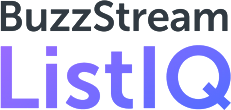
 End-to-end outreach workflow
End-to-end outreach workflow


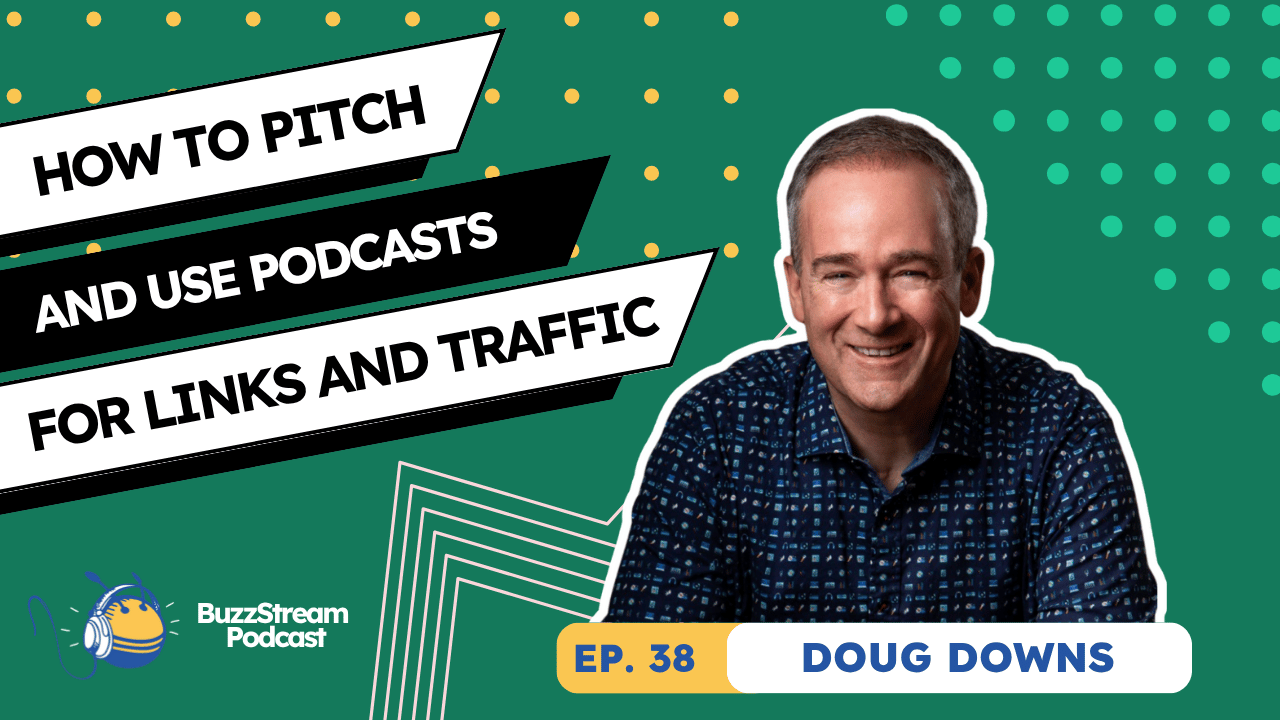
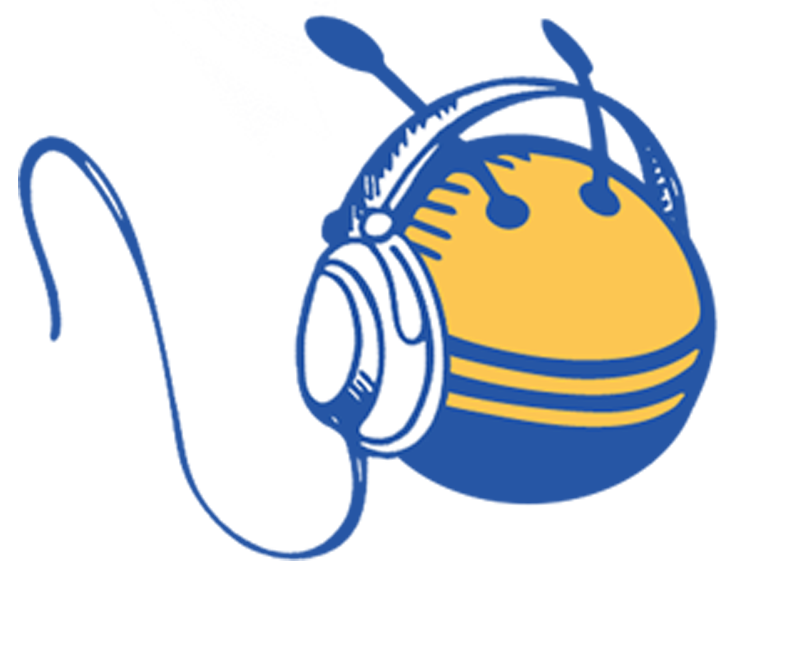 Check out the BuzzStream Podcast
Check out the BuzzStream Podcast

